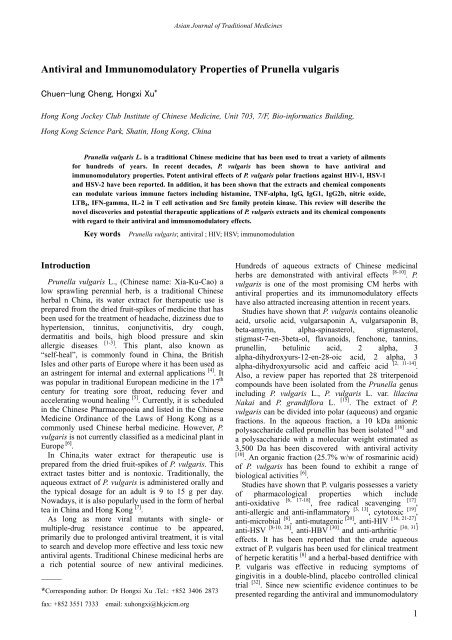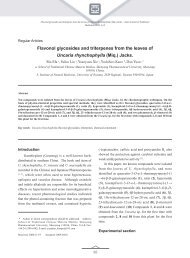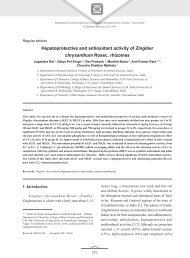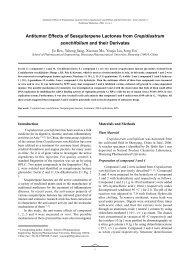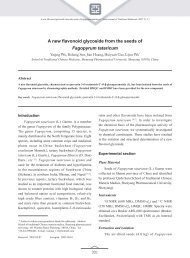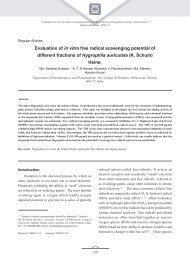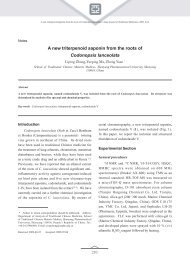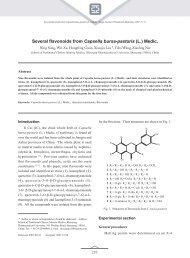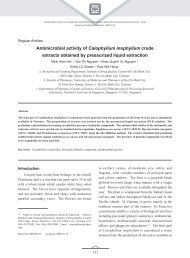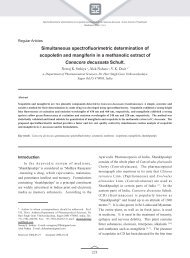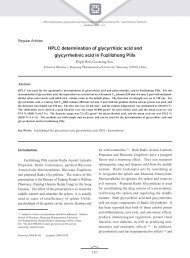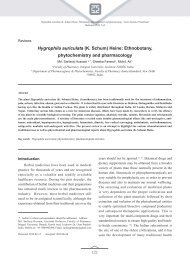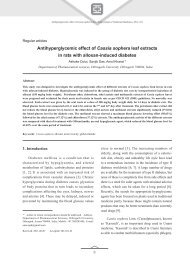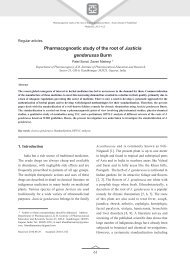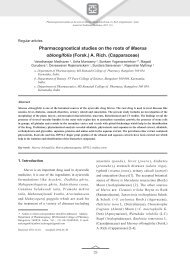Antiviral and Immunomodulatory Properties of Prunella vulgaris
Antiviral and Immunomodulatory Properties of Prunella vulgaris
Antiviral and Immunomodulatory Properties of Prunella vulgaris
- No tags were found...
Create successful ePaper yourself
Turn your PDF publications into a flip-book with our unique Google optimized e-Paper software.
Asian Journal <strong>of</strong> Traditional Medicines<strong>Antiviral</strong> <strong>and</strong> <strong>Immunomodulatory</strong> <strong>Properties</strong> <strong>of</strong> <strong>Prunella</strong> <strong>vulgaris</strong>Chuen-lung Cheng, Hongxi Xu *Hong Kong Jockey Club Institute <strong>of</strong> Chinese Medicine, Unit 703, 7/F, Bio-informatics Building,Hong Kong Science Park, Shatin, Hong Kong, China<strong>Prunella</strong> <strong>vulgaris</strong> L. is a traditional Chinese medicine that has been used to treat a variety <strong>of</strong> ailmentsfor hundreds <strong>of</strong> years. In recent decades, P. <strong>vulgaris</strong> has been shown to have antiviral <strong>and</strong>immunomodulatory properties. Potent antiviral effects <strong>of</strong> P. <strong>vulgaris</strong> polar fractions against HIV-1, HSV-1<strong>and</strong> HSV-2 have been reported. In addition, it has been shown that the extracts <strong>and</strong> chemical componentscan modulate various immune factors including histamine, TNF-alpha, IgG, IgG1, IgG2b, nitric oxide,LTB 4 , IFN-gamma, IL-2 in T cell activation <strong>and</strong> Src family protein kinase. This review will describe thenovel discoveries <strong>and</strong> potential therapeutic applications <strong>of</strong> P. <strong>vulgaris</strong> extracts <strong>and</strong> its chemical componentswith regard to their antiviral <strong>and</strong> immunomodulatory effects.Key words<strong>Prunella</strong> <strong>vulgaris</strong>; antiviral ; HIV; HSV; immunomodulationIntroduction<strong>Prunella</strong> <strong>vulgaris</strong> L., (Chinese name: Xia-Ku-Cao) alow sprawling perennial herb, is a traditional Chineseherbal n China, its water extract for therapeutic use isprepared from the dried fruit-spikes <strong>of</strong> medicine that hasbeen used for the treatment <strong>of</strong> headache, dizziness due tohypertension, tinnitus, conjunctivitis, dry cough,dermatitis <strong>and</strong> boils, high blood pressure <strong>and</strong> skinallergic diseases[1-3] . This plant, also known as“self-heal”, is commonly found in China, the BritishIsles <strong>and</strong> other parts <strong>of</strong> Europe where it has been used asan astringent for internal <strong>and</strong> external applications [4] . Itwas popular in traditional European medicine in the 17 thcentury for treating sore throat, reducing fever <strong>and</strong>accelerating wound healing [5] . Currently, it is scheduledin the Chinese Pharmacopoeia <strong>and</strong> listed in the ChineseMedicine Ordinance <strong>of</strong> the Laws <strong>of</strong> Hong Kong as acommonly used Chinese herbal medicine. However, P.<strong>vulgaris</strong> is not currently classified as a medicinal plant inEurope [6] .In China,its water extract for therapeutic use isprepared from the dried fruit-spikes <strong>of</strong> P. <strong>vulgaris</strong>. Thisextract tastes bitter <strong>and</strong> is nontoxic. Traditionally, theaqueous extract <strong>of</strong> P. <strong>vulgaris</strong> is administered orally <strong>and</strong>the typical dosage for an adult is 9 to 15 g per day.Nowadays, it is also popularly used in the form <strong>of</strong> herbaltea in China <strong>and</strong> Hong Kong [7] .As long as more viral mutants with single- ormultiple-drug resistance continue to be appeared,primarily due to prolonged antiviral treatment, it is vitalto search <strong>and</strong> develop more effective <strong>and</strong> less toxic newantiviral agents. Traditional Chinese medicinal herbs area rich potential source <strong>of</strong> new antiviral medicines.______*Corresponding author: Dr Hongxi Xu .Tel.: +852 3406 2873fax: +852 3551 7333 email: xuhongxi@hkjcicm.orgHundreds <strong>of</strong> aqueous extracts <strong>of</strong> Chinese medicinalherbs are demonstrated with antiviral effects [8-10] . P.<strong>vulgaris</strong> is one <strong>of</strong> the most promising CM herbs withantiviral properties <strong>and</strong> its immunomodulatory effectshave also attracted increasing attention in recent years.Studies have shown that P. <strong>vulgaris</strong> contains oleanolicacid, ursolic acid, vulgarsaponin A, vulgarsaponin B,beta-amyrin, alpha-spinasterol, stigmasterol,stigmast-7-en-3beta-ol, flavanoids, fenchone, tannins,prunellin, betulinic acid, 2 alpha, 3alpha-dihydroxyurs-12-en-28-oic acid, 2 alpha, 3alpha-dihydroxyursolic acid <strong>and</strong> caffeic acid [2, 11-14] .Also, a review paper has reported that 28 triterpenoidcompounds have been isolated from the <strong>Prunella</strong> genusincluding P. <strong>vulgaris</strong> L., P. <strong>vulgaris</strong> L. var. lilacinaNakai <strong>and</strong> P. gr<strong>and</strong>iflora L. [15] . The extract <strong>of</strong> P.<strong>vulgaris</strong> can be divided into polar (aqueous) <strong>and</strong> organicfractions. In the aqueous fraction, a 10 kDa anionicpolysaccharide called prunellin has been isolated [16] <strong>and</strong>a polysaccharide with a molecular weight estimated as3,500 Da has been discovered with antiviral activity[10] . An organic fraction (25.7% w/w <strong>of</strong> rosmarinic acid)<strong>of</strong> P. <strong>vulgaris</strong> has been found to exhibit a range <strong>of</strong>biological activities [6] .Studies have shown that P. <strong>vulgaris</strong> possesses a variety<strong>of</strong> pharmacological properties which include[6,anti-oxidative17-18] , free radical scavenging[17] ,anti-allergic <strong>and</strong> anti-inflammatory [3, 13] , cytotoxic [19] ,anti-microbial [6] , anti-mutagenic [20] , anti-HIV [16, 21-27] ,anti-HSV [8-10, 28] , anti-HBV [30] [30, 31]<strong>and</strong> anti-arthriticeffects. It has been reported that the crude aqueousextract <strong>of</strong> P. <strong>vulgaris</strong> has been used for clinical treatment<strong>of</strong> herpetic keratitis [8] <strong>and</strong> a herbal-based dentifrice withP. <strong>vulgaris</strong> was effective in reducing symptoms <strong>of</strong>gingivitis in a double-blind, placebo controlled clinicaltrial [32] . Since new scientific evidence continues to bepresented regarding the antiviral <strong>and</strong> immunomodulatory1
Asian Journal <strong>of</strong> Traditional Medicineseffects, this review will focus on these novel properties<strong>and</strong> future therapeutic potential.<strong>Antiviral</strong> activities <strong>of</strong> <strong>Prunella</strong> <strong>vulgaris</strong> againstHIV-1, HSV-1 <strong>and</strong> HSV-2A number <strong>of</strong> antiviral studies <strong>of</strong> P. <strong>vulgaris</strong> extractshave been carried out <strong>and</strong> active compounds against HIV<strong>and</strong> HSV have been identified (Table 1), especially in itspolar fractions. A 10 kDa anionic sulfatedpolysaccharide called prunellin was found to inhibit thereplication <strong>of</strong> HIV-1 [16] . In addition, the extract <strong>of</strong> P.<strong>vulgaris</strong> demonstrated a significant inhibitory effect onHIV-1 replication with relatively low cytotoxicityin-vitro <strong>and</strong> it was able to arrest the cell-celltransmission <strong>of</strong> HIV-1, prevent syncytium formation <strong>and</strong>interfere with both HIV-1 <strong>and</strong> purified gp120 bindingto CD4 receptors [21] . Similar results have been obtainedin further studies involving the inhibitory mechanism <strong>of</strong>HIV-1 infection in vitro by a purified extract <strong>of</strong> P.<strong>vulgaris</strong> [25] . The polyphenols <strong>and</strong> tannins <strong>of</strong> P. <strong>vulgaris</strong>have been suggested to be the major inhibitors <strong>of</strong> HIV-1gp41 six-helix bundle formation which is a critical stepin the membrane fusion between the HIV <strong>and</strong> its targetcells [17] . Also, it has been reported that an aqueousextract <strong>of</strong> P. <strong>vulgaris</strong> inhibited HIV-1 integrase activity[26] .Previously, anti-HSV activity <strong>of</strong> the aqueous extract<strong>of</strong> P. <strong>vulgaris</strong> has been described [8] . Out <strong>of</strong> one hundred<strong>and</strong> forty two kinds <strong>of</strong> traditional medicines, it has beenfound that the hot aqueous extract <strong>of</strong> P. <strong>vulgaris</strong>selectively inhibited HSV-1 [9] . Xu <strong>and</strong> co-authorsreported that a water soluble polysaccharide componentin P. <strong>vulgaris</strong>, which could be extracted with hot water,precipitated in ethanol <strong>and</strong> then purified by gelpermeation column chromatography, exhibited potentanti-HSV activity. The 50% plaque reduction dose <strong>of</strong> thepolysaccharide for HSV-1 <strong>and</strong> HSV-2 was 10 mg/ml <strong>and</strong>similar inhibitory effects were also exhibited againstacyclovir-resistant(TK-deficient or polymerase-defective)strains <strong>of</strong> HSV-1 <strong>and</strong> HSV-2 [10] . Furthermore, a studyusing the polysaccharide fraction <strong>of</strong> P. <strong>vulgaris</strong> showed areduction in the expression <strong>of</strong> HSV-1 <strong>and</strong> HSV-2antigens in their host Vero cells. Interestingly, thepolysaccharide fraction <strong>of</strong> P. <strong>vulgaris</strong> was also shown tohave an inhibitory effect on an acyclovir-resistant strain<strong>of</strong> HSV-1, ranging from 24.8 to 92.6% at 25-100 mg/ml,<strong>and</strong> it was suggested to have a different mode <strong>of</strong>anti-HSV action from that <strong>of</strong> acyclovir [28] .<strong>Immunomodulatory</strong> effects <strong>of</strong> P. <strong>vulgaris</strong>The immunomodulatory effects <strong>of</strong> P. <strong>vulgaris</strong> havereceived increasing attention in recent years. The keypromising immunomodulatory effects <strong>of</strong> differentextracts <strong>and</strong> chemical constituents isolated from P.<strong>vulgaris</strong> have been demonstrated in different models <strong>and</strong>these are summarized below (Table 2).Table 1<strong>Antiviral</strong> properties <strong>of</strong> <strong>Prunella</strong> <strong>vulgaris</strong> <strong>and</strong> its active components<strong>Antiviral</strong> actions Active components ReferencesInhibition <strong>of</strong> HIV replication Prunellin [16]Prevention <strong>of</strong> viral attachment to CD4 receptors Active component with a molecular weight <strong>of</strong> 10 kDa [21]Suppression <strong>of</strong> the replication <strong>of</strong> HIV-1(IC100=16 microgram/ml)Hot water extract [22]Inhibition <strong>of</strong> HSV-1 plaque formation Hot water extract [9]Inhibition <strong>of</strong> HIV-1 reverse transcriptase activity Aqueous extract [23]Suppression <strong>of</strong> HSV <strong>and</strong> acyclovir-resistant strains <strong>of</strong> HSV-1<strong>and</strong> HSV-2 by competing for cell receptors (50% plaquereduction=10 microgram/ml); <strong>and</strong> inhibitory effects at early<strong>and</strong> late stages <strong>of</strong> virus replicationInhibition <strong>of</strong> HIV-1 integrase activity(EC50=45 microgram/ml)Suppression <strong>of</strong> HIV-1 entry by disrupting the gp41 six-helixbundle formation (at 50 microgram/ml, 86.2% inhibition)Suppression <strong>of</strong> the expression <strong>of</strong> HSV-1 <strong>and</strong> HSV-2 antigens<strong>and</strong> also the acyclovir-resistant strain <strong>of</strong> HSV-1 (EC50 <strong>of</strong> theHSV-1 <strong>and</strong> HSV-2 antigens were 20.6 <strong>and</strong> 20.1microgram/ml, respectively)A polysaccharide with a molecular weight <strong>of</strong> 3,500Da[10]Tannin or polyphenols [26]Tannin or polyphenols [27]A polysaccharide fraction [28]2
Asian Journal <strong>of</strong> Traditional MedicinesTable 2 <strong>Immunomodulatory</strong> properties <strong>of</strong> <strong>Prunella</strong> <strong>vulgaris</strong> <strong>and</strong> its active components<strong>Immunomodulatory</strong> actions Active components ReferencesInhibition <strong>of</strong> nitric oxide production Ursolic acid, 2 alpha-hydroxyursolic acid [13]Inhibition <strong>of</strong> histamine <strong>and</strong> TNF-alpha release Aqueous extract [3]Inhibition <strong>of</strong> interleukin-2 gene expression Methanol extract, rosmarinic acid [33]Organic fraction containing 25.7% <strong>and</strong>Inhibition <strong>of</strong> 5-lipoxygenase activity0.32% rosmarinic acid <strong>and</strong> caffeic acidrespectively[6]Inhibition <strong>of</strong> Src family protein kinase, IL-2 <strong>and</strong> INF-gamma Rosmarinic acid [37]Reduction <strong>of</strong> total IgG, IgG1 <strong>and</strong> IgG2b levels Ethanol extract <strong>of</strong> Spica <strong>Prunella</strong>e [34]Stimulation <strong>of</strong> superoxide <strong>and</strong> nitric oxide Polysaccharide fraction PV2 [35]Stimulation <strong>of</strong> proteins levels <strong>of</strong> iNOS <strong>and</strong> mRNA TNF-alpha Polysaccharide fraction PV2IV [36]The effect <strong>of</strong> an aqueous extract <strong>of</strong> P. <strong>vulgaris</strong> (PVAE)has been tested on immediate-type allergic reactions. Inrats, when pretreatment with PVAE at concentrationsranging from 0.005 to 1 g/kg was applied, the serumhistamine levels induced by compound 48/80 werereduced. Also, PVAE (0.001 to 1 g/kg) inhibited thepassive cutaneous anaphylaxis activated byanti-dinitrophenyl(DNP) IgE antibody in adose-dependent manner <strong>and</strong> inhibited the histaminerelease induced by compound 48/80 or anti-DNP IgEfrom rat peritoneal mast cells (RPMC). Moreover,significant suppression <strong>of</strong> anti-DNP IgE-mediated tumornecrosis factor-alpha production from RPMC has beenreported [3] .It has also been reported that the methanol extract <strong>of</strong> P.<strong>vulgaris</strong> with rosmarinic acid inhibited interleukin-2(IL-2) gene expression by 50 % in Jurkat cellsstimulated with anti-CD3 <strong>and</strong> anti-CD4 antibodies. Inaddition, it has been shown to have an inhibitory effecton the intracellular [Ca 2+ ] increase in Jurkat cells after Tcell activation. It has been suggested that rosmarinic acidhas the potential to specifically inhibit lymphocytecell-specific kinase (Lck) Src -homology 2 (SH2)domain binding to its cognate lig<strong>and</strong>, including ZAP-70,Cbl, HS-1, <strong>and</strong> PLCgamma1, <strong>and</strong> the Lck-dependentCa 2+ signaling pathway <strong>of</strong> its downstream effector <strong>and</strong> tomodulate IL-2 gene expression after T cell activation [33] .Recently, the ethanol extract <strong>of</strong> Spica <strong>Prunella</strong>e(EESP) was shown to significantly inhibit concanavalinA-, lipopolysaccharide- <strong>and</strong> ovalbumin-inducedsplenocyte proliferation in immunized mice. It wasfound that the total IgG, IgG1 <strong>and</strong> IgG2b levels in theimmunized mice were significantly reduced by EESP.Moreover, the suppression <strong>of</strong> the antibody responses toovalbumin in the immunized mice was dose-dependentlyenhanced in parallel with the increase in EESP. Theresults suggest that EESP is able to reduce cellular <strong>and</strong>humoral responses in mice [34] .In an activity-guided fractionation <strong>of</strong> the P. <strong>vulgaris</strong>extract, a compound, 2 alpha, 3 alpha-dihydroxyursolicacid, was isolated <strong>and</strong> shown to significantly inhibit therelease <strong>of</strong> beta-hexosaminidase from cultured RBL-2H3cells. Other isolated compounds, including ursolic acid<strong>and</strong> 2 alpha-hydroxyursolic acid, were found to inhibitthe production <strong>of</strong> nitric oxide in cultured murinemacrophages, RAW 264.7 cells [13] .An organic fraction <strong>of</strong> P. <strong>vulgaris</strong>, containing 25.7% <strong>and</strong> 0.32% rosmarinic acid <strong>and</strong> caffeic acid, respectively, markedly inhibited 5-lipoxygenase, a key enzyme in leukotriene B4 biosynthesis, in bovine pol-ymorphonuclear leukocytes in vitro [6] .A polysaccharide fraction isolated from P. <strong>vulgaris</strong>,named PV2, markedly stimulated the production <strong>of</strong>superoxide <strong>and</strong> nitrite, representing nitric oxide, frommurine macrophage RAW264.7 <strong>and</strong> brain macrophageBV2 cells. The amount <strong>of</strong> nitrite <strong>and</strong> superoxideproduced after PV2 stimulation was as high as that seenafter stimulation using bacterial endotoxinlipopolysaccharide (LPS) [35] . Furthermore, the PV2IVfraction also stimulated the production <strong>of</strong> protein levels<strong>of</strong> iNOS <strong>and</strong> mRNA TNF-alpha [36] .In a large-scale screening <strong>of</strong> plant extracts, rosmarinic3
Asian Journal <strong>of</strong> Traditional Medicinesacid in extracts <strong>of</strong> P. <strong>vulgaris</strong> consistently inhibited theinteraction between Lck SH2 <strong>and</strong> a peptide containingits consensus binding sequence at pYEEI. It was shownthat the inhibitory effect <strong>of</strong> rosmarinic acid was specificfor the SH2 domains <strong>of</strong> Src family protein tyrosinekinase. It was also found that rosmarinic acid inhibitedTCR-induced-Ca 2+ mobilization <strong>and</strong> IL-2 promoteractivation. Thus, this suggested the inhibition involvedthe membrane proximal site <strong>of</strong> TCR signaling <strong>and</strong>showed that rosmarinic acid inhibited the expression <strong>of</strong>cytokines, such as IL-2 <strong>and</strong> IFN-gamma [37] .Overall perspectivesThe above results provide ample evidence <strong>of</strong> theantiviral <strong>and</strong> immunomodulatory properties <strong>of</strong> P.<strong>vulgaris</strong>. Most importantly, its active components inaqueous extracts have been studied in detail <strong>and</strong> potentantiviral activity againt HIV, HSV <strong>and</strong> HSV mutantshave been demonstrated. Furthermore, severalcompounds like prunellin, tannins, polyphenols <strong>and</strong> itspolysaccharides exhibit strong inhibitory effects on HIV<strong>and</strong> HSV. The mechanisms <strong>of</strong> action may involvesuppression <strong>of</strong> the early or late stages <strong>of</strong> viral replication,integrase activity, blocking <strong>of</strong> surface glycoproteins <strong>and</strong>viral antigens. Interestingly, the immunomodulatoryeffects <strong>of</strong> P. <strong>vulgaris</strong> may act synergistically with itsanti-viral effects. The polysaccharide fractions <strong>of</strong> P.<strong>vulgaris</strong> could not only markedly stimulate theproduction <strong>of</strong> superoxide <strong>and</strong> nitrite, representing nitricoxide, from murine macrophage RAW264.7 <strong>and</strong> brainmacrophage BV2 cells, but also the protein levels <strong>of</strong>inducible nitric oxide synthase (iNOS) <strong>and</strong> the mRNA ortumor necrosis factor alpha [35, 36] . The actions <strong>of</strong> P.<strong>vulgaris</strong> extracts on immune factors like histamine, IL-2,TNF-alpha, IgG, IgG1, IgG2b, nitric oxide, Src familyprotein kinase <strong>and</strong> T cell activation may be associatedwith specific cell targets during inflammatory <strong>and</strong>allergic actions. P. <strong>vulgaris</strong> exhibits significant dualproperties in the areas mentioned. These results confirmthat P. <strong>vulgaris</strong> is able to act as a new <strong>and</strong> effectiveantiviral agent with low toxicity. However, morein-depth studies on the chemical components <strong>of</strong> P.<strong>vulgaris</strong> need to be carried out to advance the search foreffective antiviral agents. Also, it is essential to carry outresearch on the co-administration <strong>of</strong> the active fractionswith currently used antiviral agents, a cocktail treatment,to examine their effect on HSV <strong>and</strong> HIV infections.Clinically, the extract <strong>of</strong> P. <strong>vulgaris</strong> has been developed<strong>and</strong> used in oral hygiene products for the control <strong>of</strong>gingivitis <strong>and</strong> in eye drops for the treatment <strong>of</strong> keratitisdue to the herpes infection. Considering the differentpathways <strong>of</strong> transmission <strong>of</strong> viral infections, commonlythrough the mucosae (e.g. labial <strong>and</strong> genital herpes),novel topical agents with good antiviral <strong>and</strong>immunomodulatory effects need to be developed toprevent sexually transmitted infections including HSV<strong>and</strong> HIV.To conclude, the combined properties <strong>of</strong> P. <strong>vulgaris</strong>suggest that it has great potential as a treatment for viralinfections as well as immunological disorders.References[1] World Health Organization. WHO Regional Publications,Western Pacific Series No.2, Medicinal Plants in China – Aselection <strong>of</strong> 150 commonly used species. 1989, P. 231[2] Namba T. The Encyclopedia <strong>of</strong> Wakan-Yaku (TraditionalSino-Japanese Medicines), vol. II. Hoikusha Publishing Co. Osaka,Japan. 1994. P.120-1[3] Shin TY, Kim YK, Kim HM. Inhibition <strong>of</strong> Immediate-typeallergic reactions by <strong>Prunella</strong> <strong>vulgaris</strong> in a murine model.Immunopharmacol Immunotoxicol 2001: 23(3): 423-35[4] Grieve M. A Modern Herbal. Hafner Press, New York. 1974.[5] Matthiolus PA. Kräutherbuch, Noringberg.1626.[6] Psotova J, Kolar M, Sousek J, Svagera Z, Vicar J, Ulrichova J.Biological activities <strong>of</strong> <strong>Prunella</strong> <strong>vulgaris</strong> extract. Phytother Res2003:17: 1082-7[7] Hu SY. Herbal teas <strong>and</strong> populace health care in tropical China.Am J Chin Med 1997:25(1):103-34[8] Zheng M. Experimental study <strong>of</strong> 472 herbs with antiviralaction against the herpes simplex virus. Zhong Xi Yi Jie He ZaZhi. 1990:10(1): 39-41, 46 (In Chinese)[9] Kurokawa M, Ochiai H, Nagasaka K, Neki M, Xu HX, KadotaS, et al. <strong>Antiviral</strong> traditional medicines against herpes simplexvirus (HSV-1), poliovirus, <strong>and</strong> measles virus in vitro <strong>and</strong> theirtherapeutic efficacies for HSV-1 infection in mice. <strong>Antiviral</strong> Res1993: 22: 175-88[10] Xu HX, Lee SHS, Lee SF, White RL, Blay J. Isolation <strong>and</strong>characterization <strong>of</strong> an anti-HSV polysaccharide from <strong>Prunella</strong><strong>vulgaris</strong>. <strong>Antiviral</strong> Res 1999: 44: 43-54[11] Wang ZJ, Zhao YY, Tu GZ, Hong SL, Chen YY. Studies onthe chemical constituents from <strong>Prunella</strong> <strong>vulgaris</strong>. ActaPharmaceutica Sinica. 1999: 34(9): 679-81. (In Chinese)[13] Ryu SY, Oak MH, Yoon SK, Cho DI, Yoo GS, Kim TS, et al.Anti-allergic <strong>and</strong> anti-inflammatory triterpenes from the herb <strong>of</strong><strong>Prunella</strong> <strong>vulgaris</strong>. Planta Med 2000: 66: 358-60[14] Tian J, Xiao ZY, Chen YY, Zhao YY, Wang ZJ. Structureidentification <strong>of</strong> vulgarsaponin A. Acta Pharmaceutica Sinica2000:35(1): 29-31[15] Wang ZJ, Zhao YY, Chen YY, Ma BN. Triterpenoidcompounds <strong>of</strong> <strong>Prunella</strong> genus <strong>and</strong> their feature <strong>of</strong> 13C NMRspectroscopy. China Journal <strong>of</strong> Chinese Materia Medica. 2000:25(10): 583-8 (In Chinese)[16] Tabba HD, Chang RS, Smith KM. Isolation, purification, <strong>and</strong>partial characterization <strong>of</strong> prunellin, an anti-HIV component fromaqueous extracts <strong>of</strong> <strong>Prunella</strong> <strong>vulgaris</strong>. <strong>Antiviral</strong> Res 1989: 11(5-6):263-73[17] Liu F, Ng TB. Antioxidative <strong>and</strong> free radical scavengingactivities <strong>of</strong> selected medicinal herbs.Life Sci 2000: 66(8):725-35[18] Skottova N, Kazdova L, Oliyarnyk O, Vecera R, Sobolova L,Ulrichova J. Phenolics-rich extracts from Silybum marianum <strong>and</strong><strong>Prunella</strong> <strong>vulgaris</strong> reduce a high-sucrose diet induced oxidativestress in hereditary hypertriglyceridemic rats. Pharmacol Res2004:50(2): 123-30[19] Lee KH, Lin YM, Wu TS, Zhang DC, Yamagishi T, HayashiT, et al. The cytotoxic principles <strong>of</strong> <strong>Prunella</strong> <strong>vulgaris</strong>, Psychotriaserpens, <strong>and</strong> Hyptis capitata: ursolic acid <strong>and</strong> related derivatives.4
Asian Journal <strong>of</strong> Traditional MedicinesPlanta Med 1988: 54(4): 308-11[20] Lee H, Lin JY. Antimutagenic activity <strong>of</strong> extracts fromanticancer drugs in Chinese medicine. Mutat Res 1988: 204(2):229-34[21] Yao XJ, Wainberg MA, Parniak MA. Mechanism <strong>of</strong>inhibition <strong>of</strong> HIV-1 infection in vitro by purified extract <strong>of</strong><strong>Prunella</strong> <strong>vulgaris</strong>. Virology 1992:187(1): 56-62[22] Yamasaki K, Otake T, Mori H, Morimoto M, Ueba N,Kurokawa Y, et al. Screening test <strong>of</strong> crude drug extract onanti-HIV activity. Yakugaku Zasshi 1993: 113(11): 818-24 (InJapanese)[23] Yamasaki K, Nakano M, Kawahata T, Mori H, Otake T, UebaN, et al. Anti-HIV-1 activity <strong>of</strong> herbs in Labiatae. Bio. Pharm.Bull. 1998: 21(8), 829-833.[24] Kageyama S, Kurokawa M, Shiraki K. Extract <strong>of</strong> <strong>Prunella</strong><strong>vulgaris</strong> spikes inhibits HIV replication at reverse transcription invitro <strong>and</strong> can be absorbed from intestine in vivo. Antivir ChemChemother 2000:11(2): 157-64[25] Lam TL, Lam ML, Au TK, Ip DT, Ng TB, Fong WP, et al. Acomparison <strong>of</strong> human immunodeficiency virus type-1 proteaseinhibition activities by the aqueous <strong>and</strong> methanol extracts <strong>of</strong>Chinese medicinal herbs. Life Sci 2000: 27: 67(23): 2889-96[26] Au TK, Lam TL, Ng TB, Fong WP, Wan DC. A comparison<strong>of</strong> HIV-1 integrase inhibition by aqueous <strong>and</strong> methanol extracts <strong>of</strong>Chinese medicinal herbs. Life Sci 2001: 23: 68(14): 1687-94[27] Liu S, Jiang S, Wu Z, Lv L, Zhang J, Zhu Z, et al.Identification <strong>of</strong> inhibitors <strong>of</strong> the HIV-1 gp41 six-helix bundleformation from extracts <strong>of</strong> Chinese medicinal herbs <strong>Prunella</strong><strong>vulgaris</strong> <strong>and</strong> Rhizoma cibotte. Life Sci 2002: 71(15): 1779-91.[28] Chiu LC, Zhu W, Ooi VE. A polysaccharide fraction frommedicinal herb <strong>Prunella</strong> <strong>vulgaris</strong> downregulates the expression <strong>of</strong>herpes simplex virus antigen in Vero cells. J Ethnopharmacol2004: 93(1): 63-8[29] Zheng MS, Zhang YZ. Anti-HBsAg herbs employing ELISAtechnique. Zhong Xi Yi Jie He Za Zhi 1990: 10(9): 560-62, 518.(In Chinese)[30] Jung YB, Roh KJ, Jung JA, Jung K, Yoo H, Cho YB, et al.Effect <strong>of</strong> SKI 306X, a new herbal anti-arthritic agent, in patientswith osteoarthritis <strong>of</strong> the knee: a double-blind placebo controlledstudy. Am J Chin Med 2001: 29(3-4): 485-91[31] Choi JH, Choi JH, Kim DY, Yoon JH, Youn HY, Yi JB, et al.Effects <strong>of</strong> SKI 306X, a new herbal agent, on proteoglyc<strong>and</strong>egradation in cartilage explant culture <strong>and</strong> collagenase-inducedrabbit osteoarthritis model. Osteoarthritis Cartilage 2002: 10(6):471-8[32] Adamkova H, Vicar J, Palasova J, Ulrichova J, Simanek V.Macleya cordata <strong>and</strong> <strong>Prunella</strong> <strong>vulgaris</strong> in oral hygiene products –their efficacy in the control <strong>of</strong> gingivitis. Biomed Pap Med FacUniv Palacky Olomouc Czech Repub 2004: 148(1): 103-5[33] Ahn SC, Oh WK, Kim BY, Kang DO, Kim MS, Heo GY, etal. Inhibitory effects <strong>of</strong> rosmarinic acid on Lck SH2 domainbinding to a synthetic phosphopeptide. Planta Med 2003: 69(7):642-6[34] Sun HX, Qin F, Pan YJ. In vitro <strong>and</strong> in vivoimmunosuppressive activity <strong>of</strong> Spica <strong>Prunella</strong>e ethanol extract onthe immune responses in mice. J Ethnopharmacol. 2005: 3:101(1-3): 31-6[35] Fang X, Chang RC, Yuen WH, Zee SY. Immune modulatoryeffects <strong>of</strong> <strong>Prunella</strong> <strong>vulgaris</strong> L. Int J Mol Med 2005: 15(3): 491-6[36] Fang X, Yu MM, Yuen WH, Zee SY, Chang RC.. Immunemodulatory effects <strong>of</strong> <strong>Prunella</strong> <strong>vulgaris</strong> L. onmonocytes/macrophages. Int J Mol Med 2005: 16(6): 1109-16[37] Won J, Hur YG., Hur EM, Park SH, Kang MA, Choi Y, et al.Rosmarinic acid inhibits TCR-induced T cell activation <strong>and</strong>proliferation in an Lck-dependent manner. Eur. J. Immunol. 2003:33(4): 870-95


